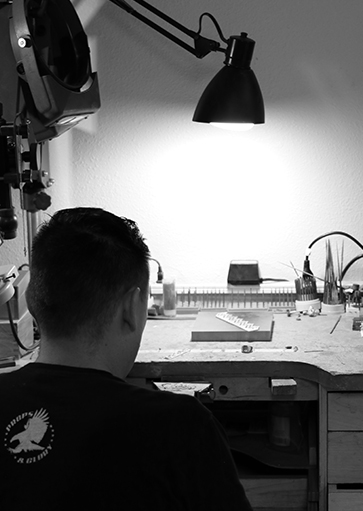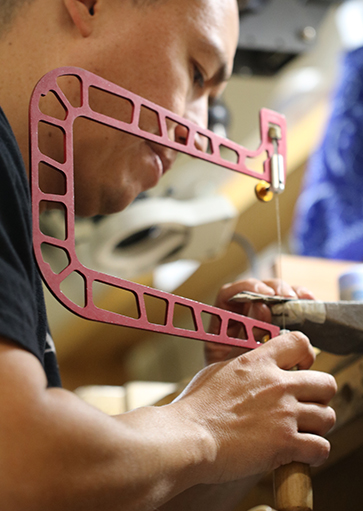ABOUT JONATHAN
I make jewelry with my hands…
Jonathan McKinney is a product of two worlds. His mother is a member of Acoma Pueblo and his father, who is white, comes from a Celtic background. Both parents offered him a strong cultural lineage and today Jonathan combines both legacies in his art.
Born in Gallup, Jonathan’s father ran a large production shop which hired and trained Native American artists. When he was five, his mother and sisters were in a bad car accident, leaving his older sister with a traumatic brain injury. Seeking care for her led the family to move to Albuquerque.
Jonathan began making jewelry himself at the age of nine. His first piece was a simple silver ring with a cabochon on top. All through middle school and high school, he entered pieces in the Gallup Intertribal Ceremonial, where they won him several awards. Jonathan had also found another love: playing competitive soccer. This newfound love proved to be somewhat of a distraction, as competing internationally in soccer led him to pass up some opportunities to exhibit his art.
REDEFINING FASHION
Attending college at Dartmouth offered him new ways to use his skills as an artist. Jonathan taught jewelry-making to other students there as a part-time job. Back home, he began working full-time with his father, who had started a company called Teme. Teme was the name given his father by Jonathan’s maternal grandfather. It is a word that means “jewelry maker” or someone who works with treasures.
In 2007, he and his family sold the company to Navajo Arts and Crafts, a tribally owned enterprise. As a condition of the sale, they had to sign an agreement not to compete with the new owners for six years. This agreement kept Jonathan from making Native American jewelry or doing inlay work for that time period. Looking for other outlets, he and his father designed a new collection of men’s jewelry, which they launched in 2007. Due to the recession, the collection was not as successful as they’d hoped. Their next venture, creating biker jewelry, would be more of a hit. Through their attendance at biker rallies, their new collection sold very well.
REDEFINING STYLE
The next step on Jonathan’s journey brought a move to Las Vegas, Nevada. There he worked with American designer Judith Ripka for a while before he was scouted by Van Cleef, a French jewelry company. His time with Van Cleef taught him about both designing and creating pieces along with creating a good business model. He learned how to structure collections so they pulled in sales. It was a strong addition to his skill base.
With the time of the non-compete agreement up, Jonathan sought ways to combine both facets of his heritage into his art. He admits to a phase where he didn’t want to be known as a “Native American” artist. The stereotypes and expectations that too often come with that label felt like restrictions on his creativity. Once he found that he could let go of the concern over what others thought of his work, he moved away from that worry. Today, he integrates both sides of his background into the jewelry he makes, saying “I don’t want my jewelry to reflect only one side of me.”
His journey has been impacted in other ways as well. “Everyone’s always trying to figure out your method and material and if it’s a valid thing for you to be doing,” he says. “I come from a different perspective, having that background in manufacturing.” For him, the design is first. The design drives how he creates a piece and what materials he uses for it. He says, “I think about inspirations that speak to me and try to create something in my mind that’s captivating to me. Then I use the tools I have to create it.”
He draws inspiration from his connection to Acoma and from his family there. Renowned potter Lucy Lewis was his grandmother’s sister. She researched ancient Mimbres designs for her pottery and today Jonathan reinterprets those designs for his jewelry. Some of his work combines the ancient Celtic designs of his father’s heritage with those from Acoma, blending both sides of who he is into one piece.


